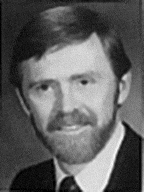


Editorial
Holography with X-rays

X-ray holograms with atomic resolution have been made by two groups (M. Tegze and G. Faigel, Nature 380, 49, 1996; T. Gog et al, Phys. Rev. Lett. 76, 3132, 1996). These are exciting and important results. However, some of the claims by the investigators that were taken up by the science news media can distract the reader from the true significance of the powerful new technique.
The paper by Tegze and Faigel begins: "Diffraction methods for crystallographic structure determination suffer from the so-called 'phase problem'; a diffraction pattern provides intensity but not phase information for the scattered beams, and therefore cannot be uniquely inverted to obtain the crystal structure of the sample."
The statement is at best misleading. A diffraction pattern does provide phase information that can be extracted directly from the observed intensities and unique solutions have been identified in thousands of cases. The work of Don Casper, David Harker, Herb Hauptman, Isabella Karle, Jerome Karle, David Sayre, Michael Wolfson, and others facilitated tens of thousands of direct methods solutions that contribute to the exponential growth of the Cambridge Structural Database.
Reading the "News and Views" piece by Charles Fadley and Patrick Len in the same issue of Nature, one finds the following statement:
"Such structure determinations must still be done by a trial and error methodology, in which diffraction spot intensities are calculated for various possible atomic geometries and compared with experimental intensities."
In 1996, programs for phase determination such as SHELX-95 and Shake-n-Bake make it possible to identify a unique solution to the phase problem time and time again, eliminating the need to explore "various possible atomic geometries". The possibility that an incorrect set of phases exists that corresponds to a homometric nonsense solution has been used to call into question the potential for uniquely inverting the phase information contained in the diffraction pattern in the past. The homometric solution belongs in the same category as the Loch Ness monster and the abominable snowman. Older members of the community will recall the extended debates about the existence of the abominable homometric solution that followed presentations by Karle and Hauptman in the early 50's.
In a well balanced appraisal of the new discovery, Science reporter Steve Nadis comments that holography promises to complement the established technique of X-ray crystallography nicely and quotes Peter Stephens, a physicist at the State U. of New York, Stony Brook, as saying: "Crystallography is used to determine the average structure of ordered solids. Holography, on the other hand, can give you information about local structure that is not seen by crystallography. It offers a way of focusing on the deviations from the average - the special cases that may be buried in a repeating world." This is the real significance of the work of Tegze and Gog and their coworkers. Miklos Tegze is scheduled to present a paper on this work in Seattle, as is Abraham Szoke, whose 1986 work at the Laurence Livermore Laboratory was an immediate precursor to the recent breakthrough.
Our Man in Japan
The name of Yohio Mitsui has been added to the masthead. Professor Matsui has agreed to help in efforts to expand the advertising base of the IUCr Newsletter, and better serve our readers in the Pacific basin. We hope that Japanese companies that provide equipment, supplies, and services to crystallographers will be encouraged to use the IUCr Newsletter to reach not only the 1,000 crystallographers in Japan, but the 15,000 crystallographers throughout the world who may be interested in their products. I cannot repeat too often how grateful we are to all of our advertisers for their support of this newsletter which serves the world community of crystallographers.
WLD

